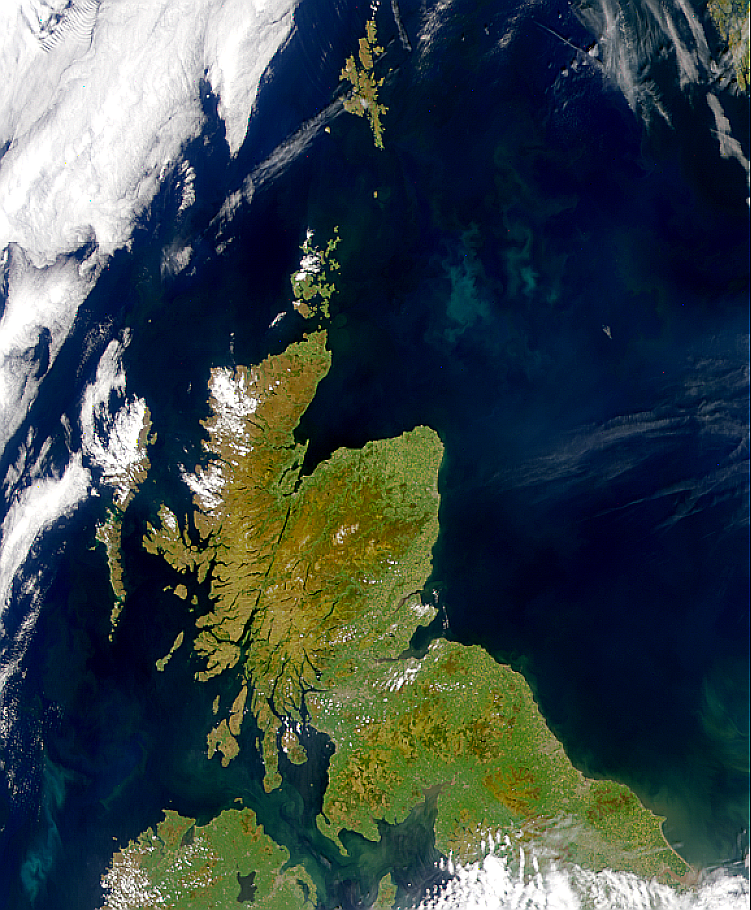story by Helen Hill


The Shetland shelf is one side of the Faroe-Shetland Channel: a deep bathymetric channel extending north-eastwards between Scotland and the Faroe Islands – Image: Wikipedia
This month we spotlight work by Arjav Trivedi and Ralf Toumi in the Space and Atmospheric Physics Group, in the Physics Dept. at Imperial College, London, UK, who have been using MITgcm to study the circulation on the Shetland Shelf system.Across-slope bottom boundary layer (BBL) fluxes on the shelf-edge connect the Shetland Shelf system to deeper waters. Such fluxes are important as they connect shallower shelf seas to deeper waters allowing shelf seas to play an outsized role in the uptake and efficient off-shelf export of atmospheric CO2.
In Mechanisms of bottom boundary fluxes in a numerical model of the Shetland shelf which appear in the journal Ocean Dynamics, Trivedi and Toumi investigated two ways in which across-slope BBL fluxes can occur: One, in regions that have a slope current aligned to the bathymetry, is the frictional veering of bottom currents termed the ‘Ekman drain’, a second through local wind-forced downwelling (wind-driven surface Ekman flow with an associated bottom flow).
The authors investigate the variability, magnitude and spatial scale of BBL fluxes on the Shetland shelf, which has a prominent slope current, using a high-resolution (∼2 km) configuration of the MITgcm. They then analyze fluxes in the BBL at the shelf break near the 200 m isobath which they find to exhibit a seasonal variability with high/low volume transport in winter/summer respectively.
Using a multivariate regression approach, the pair find that the locally wind-driven Ekman transport plays no explicit role in explaining daily bottom fluxes. Instead they posit that the variability of the across-slope BBL flux can be explained as a linear function of the speed and across-slope component of the interior flow, corresponding to an Ekman plus mean-flow flux. They estimate that the mean-flow contributes more greatly than the Ekman flux to the BBL flux., and that the spatial heterogeneity of the BBL fluxes can be attributed to the mean-flow, which they find to have a much shorter decorrelation length compared to the Ekman flux.
The authors conclude that both the speed and direction of the interior current determines the daily BBL flux, while the wind does not explicitly contribute through local downwelling, although it may influence the interior current and therefore implicitly the BBL fluxes on longer timescales.
To find out more about this work contact Arjav
About the Researchers

Arjav Trivedi is a PhD student at Imperial College in London. He began using MITgcm in 2013. In his spare time he coaches youth soccer.
This Month’s Featured Publication
- Trivedi, A. & Toumi, R., Mechanisms of bottom boundary fluxes in a numerical model of the Shetland shelf, Ocean Dynamics (2017) 67: 1. doi: 10.1007/s10236-016-1010-7
Other New Publications this Month
Werner Alpers (2016), SAR oceanography applied to southeast Asian Waters, Geoscience and Remote Sensing Symposium (IGARSS), 2016 IEEE International, doi: 10.1109/IGARSS.2016.7729568
Cimatoribus, Andrea A., Ulrich Lemmin, David Andrew Barry (2016),Transport and mixing in Lac Léman, 14th Swiss Geoscience Meeting, Geneva, Switzerland, 19/11/2016, pdf
Emmanouil Flaounas, Fanni Dora Kelemen, Heini Wernli, Miguel Angel Gaertner, Marco Reale, Emilia Sanchez-Gomez, Piero Lionello, Sandro Calmanti, Zorica Podrascanin, Samuel Somot, Naveed Akhter, Raquel Romera, Dario Conte (2016), Assessment of an ensemble of ocean–atmosphere coupled and uncoupled regional climate models to reproduce the climatology of Mediterranean cyclones, Climate Dynamics, doi: 10.1007/s00382-016-3398-7
Takamitsu Ito, Ou Wang (2016), Transit Time Distribution based on the ECCO-JPL Ocean Data Assimilation, Journal of Marine Systems, Volume 167, March 2017, Pages 1–10, doi: 10.1016/j.jmarsys.2016.10.015
Mehmet Ilıcak (2016), Quantifying spatial distribution of spurious mixing in ocean models, Ocean Modeling, Volume 108, December 2016, Pages 30–38, doi: 10.1016/j.ocemod.2016.11.002
Younjoo J. Lee et al. (2016), Net primary productivity estimates and environmental variables in the Arctic Ocean: An assessment of coupled physical-biogeochemical models, online at Journal of Geophysical Research – Oceans, doi: 10.1002/2016JC011993
Svetlana Losa, Julia Oelker, Marianna Soppa, Martin Losch, Tilman Dinter, Astrid Bracher (2016), Investigating Antarctic PFTs based on satellite observation and modeling, poster
Valentina Melli, Michela Angiolillo, Francesca Ronchi, , Simonepietro Canese, Otello Giovanardi, Stefano Querin, Tomaso Fortibuoni (2016), The first assessment of marine debris in a Site of Community Importance in the north-western Adriatic Sea (Mediterranean Sea), Marine Pollution Bulletin (in press), doi: 10.1016/j.marpolbul.2016.11.012
Joy Merwin Monteiro, Rodrigo Caballero (2016), Proc. of the 15th Python in Science Conference, pdf
Lars Nerger (2016), Building Ensemble-Based Data Assimilation Systems for Coupled Models, Coupled Data Assimilation Workshop, Toulouse, France, October 18-21, 2016 , pdf
Franco Jose Schutze-Betancourt (2016), Comparison of Migration Techniques for High-Performance Code to Android and iOS, BSc thesis, Department of Computer Science Algorithmic Optimal Control Christian Albrechts University, Kiel pdf
Robert Turnewitsch, Matthew Dumont, Kostas Kiriakoulakis, Sonya Legg, Christian Mohn, Florian Peine, George Wolff (2016), Tidal influence on particulate organic carbon export fluxes around a tall seamount, Progress in Oceanography, Volume 149, December 2016, Pages 189–213, doi: 10.1016/j.pocean.2016.10.009
Yu Zhang, Changsheng Chen, Robert C. Beardsley, Guoping Gao, Jianhua Qi, Huichan Lin(2016), Seasonal and interannual variability of the Arctic sea ice: A comparison between AO-FVCOM and observations, online at Journal of Geophysical Research – Oceans, doi: 10.1002/2016JC011841
Zhao, S. & Liu, Y.(2016), Spurious dianeutral mixing in a global ocean model using spherical centroidal voronoi tessellations, Journal of the Ocean University of China (2016) 15: 923. doi: 10.1007/s11802-016-3031-8
Do you have news about research using MITgcm? We are looking for contributions to these pages. If you have an interesting MITgcm project (ocean, atmosphere, sea-ice, physics, biology or otherwise) that you want to tell people about, get in touch. To make a post, contact Helen
